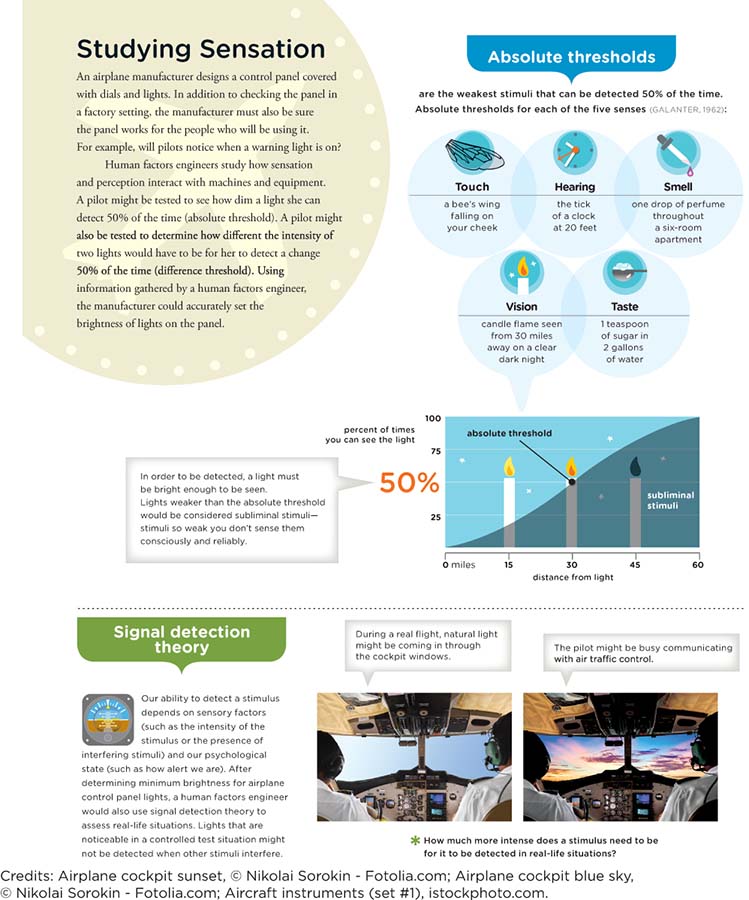Chapter 1. Chapter
Infographic
Scientific American: Psychology
Infographic Activity 3.1: Studying Sensation
Studying Sensation

An airplane manufacturer designs a control panel covered with dials and lights. In addition to checking the panel in a factory setting, the manufacturer must also be sure the panel works for the people who will be using it. For example, will pilots notice when a warning light is on? Human factors engineers study how sensation and perception interact with machines and equipment. A pilot might be tested to see how dim a light she can detect 50% of the time (absolute threshold). A pilot might also be tested to determine how different the intensity of two lights would have to be for her to detect a change 50% of the time (difference threshold). Using information gathered by a human factors engineer, the manufacturer could accurately set the brightness of lights on the panel.
Click the image to enlarge.
Click "Next" to continue.
1.1 Quiz
1. Jason and his wife are always having the same playful argument when they watch television at night. “Why do you always put the television volume so low,” asks Jason. “Why don’t you go get your hearing checked,” sighs his wife! To prove that his hearing is fine, Jason does go to get a hearing test. The woman running the test asks Jason to raise his hand any time he can hear a tone played through a pair of headphones .The volume of a sound that Jason can detect 50% of the time during this test would his ________ threshold for hearing.
| A. |
| B. |
| C. |
| D. |
2. Michael has made his “World Famous Finger Licking Fireball Chili” for his friends to enjoy during the football game. He asks his wife, Bella, to taste it and give her opinion. “It is good, but I think you need to add some more hot peppers,” she advises him. After 30 minute she tastes the chili again, and says, “I thought I told you to add more peppers!” Clearly, the amount of peppers Michael added between Bella’s first and second tastes was not enough to exceed her ________ threshold.
| A. |
| B. |
| C. |
| D. |
3. Meisha is really getting irritated with her new roommate and is thinking of asking her to move out after just a couple of weeks. The fact is that her roommate uses far too much perfume, and it is really causing an odor problem in their apartment. Every time she puts on her perfume, she spills a drop on her dressing table, and the apartment is only 3 rooms in size! Studies of the average human ability to detect an olfactory (smell) stimulus suggest that this one drop of perfume would be detectable in a larger apartment of up to _____ rooms!
| A. |
| B. |
| C. |
| D. |
4. Stimuli that are not strong enough to be detected more than 50 percent of the time would be considered ________ stimuli.
| A. |
| B. |
| C. |
| D. |
5. One’s ability to be aware of a stimulus is based not only on the intensity of the stimulus but also on the presence or absence of interfering stimuli. This is the basis of ________ theory.
| A. |
| B. |
| C. |
| D. |
6. Michaela and Robert have gone away for a weekend skiing in the mountains. While looking out of their hotel room window, they are amazed that they cannot even see the ski slopes that they were skiing on just a few hours earlier. All of the sudden Michaela sees a brief flicker of a cigarette lighter as a nighttime slope worker lights a cigar while he works up on the mountain. She remarks to Robert that she is amazed she could see it. He responds by saying, “actually, the average human being is able to see the flicker of a candle from ____ away on a dark clear night at least 50% of the time!”
| A. |
| B. |
| C. |
| D. |